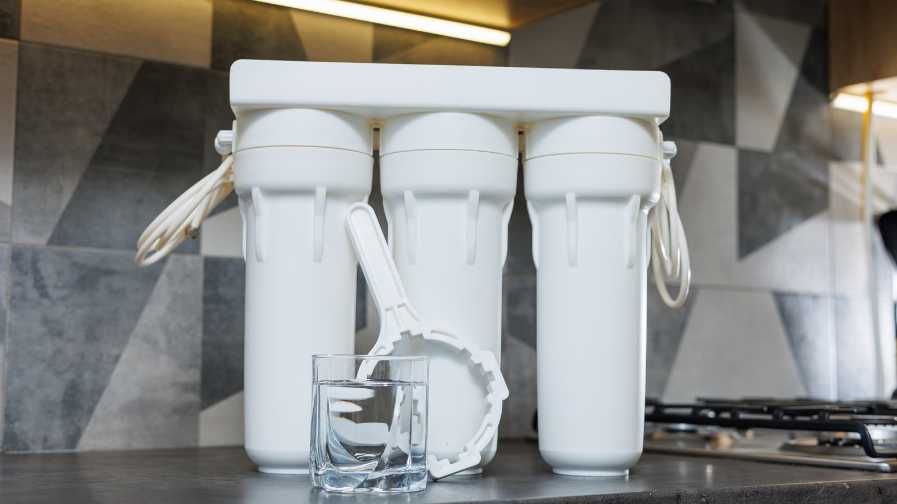GPD in water filters stands for Gallons Per Day. It’s a term that anyone looking into water purification, especially using reverse osmosis systems, will come across. Understanding GPD is crucial as it gives an insight into the efficiency and capacity of the water filter.
Understanding GPD
GPD, or Gallons Per Day, is a standard unit of measurement used in the water filtration industry, especially when discussing reverse osmosis systems.
GPD quantifies the amount of purified water a filtration system can produce within a 24-hour period. For instance, a filter rated at 50 GPD should ideally produce 50 gallons of purified water in one day.
Usage of GPD in Reverse Osmosis Systems
In the context of reverse osmosis systems, GPD is a critical metric. It helps users gauge the efficiency and capacity of the system. A higher GPD rating indicates that the system can produce a larger volume of purified water daily, making it suitable for larger households or higher consumption needs.
GPD Water Filter Meaning
GPD, or Gallons Per Day, is a crucial metric in the realm of water filtration systems. It serves as a measure of the filtration unit’s capacity, indicating the volume of water it can purify within a 24-hour period. Understanding the GPD rating is pivotal for selecting the right water filter to meet your specific needs.
In essence, GPD reflects the efficiency and output of a water filter, outlining its capability to deliver clean and safe drinking water. The higher the GPD, the more water the filter can process, making it particularly important for households with varying water consumption levels.
When exploring water filters, paying attention to the GPD rating ensures that the chosen system aligns with your daily water requirements. This comprehensive guide will delve deeper into the significance of GPD in water filters, shedding light on how this metric influences the overall performance and effectiveness of your filtration system.
What does GDP stand for in water filters? GPD in water filters stands for “Gallons Per Day,” representing the unit of measurement for the water flow rate through the filter, specifically in the context of reverse osmosis systems.
GPD vs. GPM
While GPD measures the volume of water produced in a day, GPM (Gallons Per Minute) is another metric that measures the flow rate of water through a system.
For example, a standard faucet might have a flow rate of 2 GPM, meaning it can produce 2 gallons of water every minute. In contrast, GPD is more about the cumulative output over a day, especially relevant for systems that store purified water, like reverse osmosis systems.
This article provides a concise yet in-depth understanding of GPD in the context of water filters, especially reverse osmosis systems.
1 US gallon per day (GPD) is equal to 0.000694444 US gallons per minute (GPM).
Here is a conversion table for GPD to GPM:
| GPD | GPM |
|---|---|
| 1 | 0.000694444 |
| 10 | 0.00694444 |
| 100 | 0.0694444 |
| 1000 | 0.694444 |
| 10000 | 6.94444 |
| 100000 | 69.4444 |
| 1000000 | 694.444 |
Please note that this conversion is for US gallons.
Importance of GPD in Water Filters
GPD isn’t just a random specification when it comes to water filters. Its significance is paramount, especially in the realm of reverse osmosis systems.
Crucial Specification for RO Systems
GPD serves as a benchmark for the performance of reverse osmosis systems. A system’s GPD rating directly reflects its capacity and efficiency. The higher the GPD, the more water it can purify in a day, making it a vital metric for users to consider.
Indicator of Purified Water Volume
Simply put, GPD tells you the volume of purified water a system can produce in a 24-hour period. For instance, a 100 GPD system can ideally churn out 100 gallons of clean water in a day.
Ideal GPD Ratings for RO Systems
When delving into the world of reverse osmosis systems, understanding GPD ratings is essential to make an informed choice.
Minimum Flow Rate for Residential Use:
For most households, an RO system with a GPD rating of at least 50 is recommended. This ensures that the system can cope with the daily water consumption needs of a typical family.
Efficiency Indicator:
The GPD rating is more than just a number. It’s an indicator of how efficient an RO system is. A higher GPD rating often means the system is more advanced, capable of producing more purified water in less time.
Comparing GPD Ratings:
Different RO systems come with varying GPD ratings. While a 50 GPD might be sufficient for a small family, larger households or those with higher water needs might opt for systems with 100 GPD or even higher. It’s essential to balance the GPD rating with other factors like system size, cost, and maintenance requirements.
This segment offers a deeper dive into the significance of GPD in reverse osmosis systems and how to interpret these ratings when choosing a system.
Factors Influencing GPD Ratings
GPD ratings, while standardized, can vary across different reverse osmosis systems. Several factors come into play that can influence these ratings:
Filter Size and Surface Area
Impact on Flow Rate
The size and surface area of a filter directly correlate with its flow rate. A larger filter with a more extensive surface area allows more water to pass through, leading to a higher GPD rating.
Whole Home RO Systems vs. Under-Sink Systems
Whole home RO systems are designed to cater to the water needs of an entire household. They typically have larger filters and, consequently, higher GPD ratings.
On the other hand, under-sink systems are more compact, designed for point-of-use purification. Their GPD ratings are generally lower than whole home systems due to their smaller size and targeted application.
Water Pressure
Role in Determining GPD
Water pressure plays a pivotal role in determining the GPD rating. The force exerted by the water as it moves through the system can significantly impact the flow rate.
Effect of Different Water Pressures
If the feed water flow rate is high, it can push water molecules through the RO membrane more efficiently, leading to a higher GPD. Conversely, a lower water pressure might result in a reduced flow rate and a lower GPD rating.
Number and Complexity of Filter Stages
Typical Filter Stages:
Most RO systems comprise multiple stages, including a sediment filter, a carbon filter, an RO membrane, and sometimes a post-filter.
Influence of Additional Stages on GPD:
While multiple stages ensure thorough purification, they can also introduce resistance to the flow of water. Each additional stage can potentially reduce the flow rate, impacting the overall GPD rating. For instance, systems with UV purifiers or remineralization filters might have a slightly reduced GPD due to the added complexity.
This segment provides a comprehensive understanding of the various factors that can influence the GPD ratings of reverse osmosis systems.
Comparing GPD in RO and Non-RO Filters
Reverse Osmosis (RO) and non-RO filters, while both designed for water purification, have distinct differences when it comes to GPD ratings.
Effect of RO Membranes on Flow Rates
RO membranes are designed with tiny pores to filter out even the smallest contaminants. This intricate design can restrict water flow, impacting the GPD.
Flow Rates in RO Systems
Due to the nature of the RO membrane and the multiple filtration stages, RO systems generally have slower flow rates compared to non-RO filters.
- Flow rates are an essential performance indicator for RO systems.
- Measuring and monitoring feed water flow, concentrate flow, and permeate flow can help to optimize RO system performance.
- Properly setting system pressure and flow requirements is important for optimizing multistage RO systems for high recovery rates.
Choosing the Right GPD for Your Needs
Selecting the right GPD for your RO system is more than just picking the highest number. It’s about understanding your needs and ensuring the system can meet them.
Factors to Consider
Daily Water Consumption: Estimate the daily water needs of your household. This will give you a baseline for the minimum GPD you should consider.
System Size: Ensure the physical size of the system fits the space you have, especially for under-sink installations.
Budget: Higher GPD systems might come with a heftier price tag. Balance your needs with your budget.
Balancing GPD with Other Specifications:
While GPD is a crucial metric, it’s essential to consider other system specifications. For instance, a system might have a high GPD but lacks certain filtration stages you deem necessary.
It’s also worth noting that a higher GPD might require more frequent maintenance or filter replacements. Ensure you’re comfortable with the upkeep requirements of the system you choose.
This segment provides insights into the differences in GPD between RO and non-RO filters and offers guidance on selecting the right GPD based on individual needs.
FAQs
What Does GPD Mean For Water Filters?
GPD, or gallons per day, is a measurement of the flow rate of water in a filter. It’s primarily used as a specification for reverse osmosis systems. It represents the volume of purified water produced by the system in a single day, measured in gallons.
What’s A Good GPD Rating For RO Systems?
For residential use, the minimum required water flow rate for an RO system is typically 50 gallons per day (GPD). However, some advanced RO systems can have flow rates ranging from 75-100 GPD or even higher.
How Do RO Systems Compare to Non-RO Filters in Terms of Flow Rate?
RO systems generally have slower flow rates than non-RO filters. This is because the RO membrane has tiny pores, which, despite the high pressure used, reduces the flow rate.
Conclusion
Understanding GPD in water filters, especially in reverse osmosis systems, is crucial for making an informed purchase. It not only indicates the efficiency and capacity of the system but also helps users gauge if the system will meet their daily water needs. As with any specification, it’s essential to balance GPD with other system features and requirements. Ultimately, the right water filter is one that aligns with both your water purification needs and daily consumption patterns.

Mark is a seasoned Outdoor Equipment and Heating Appliances specialist. With a passion for adventure and a keen understanding of heating solutions, he brings expertise to the world of outdoor enthusiasts. Mark’s insights, gained through years of experience, make him a go-to resource for those seeking reliable guidance in navigating the realm of outdoor gear and heating technologies.

